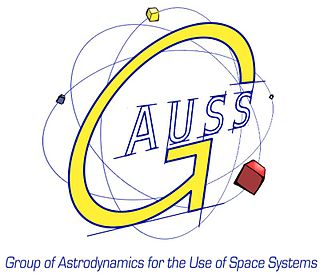IKONOS was a commercial Earth observation satellite, and was the first to collect publicly available high-resolution imagery at 1- and 4-meter resolution. It collected multispectral (MS) and panchromatic (PAN) imagery. The capability to observe Earth via space-based telescope has been called "one of the most significant developments in the history of the space age", and IKONOS brought imagery rivaling that of military spy satellites to the commercial market. IKONOS imagery began being sold on 1 January 2000, and the spacecraft was retired in 2015.

The Dnepr rocket was a space launch vehicle named after the Dnieper River. It was a converted ICBM used for launching artificial satellites into orbit, operated by launch service provider ISC Kosmotras. The first launch, on April 21, 1999, successfully placed UoSAT-12, a 350 kg demonstration mini-satellite, into a 650 km circular Low Earth orbit.

FalconSAT is the United States Air Force Academy's (USAFA) small satellite engineering program. Satellites are designed, built, tested, and operated by Academy cadets. The project is administered by the USAFA Space Systems Research Center under the direction of the Department of Astronautics. Most of the cadets who work on the project are pursuing a bachelor of science degree in astronautical engineering, although students from other disciplines join the project.

China–Brazil Earth Resources Satellite 1 (CBERS-1), also known as Ziyuan I-01 or Ziyuan 1A, is a remote sensing satellite which was operated as part of the China–Brazil Earth Resources Satellite program between the China National Space Administration and Brazil's National Institute for Space Research. The first CBERS satellite to fly, it was launched by China in 1999.
Deimos-1 is a Spanish Earth imaging satellite which is operated by Deimos Imaging who commercializes its imagery directly but also has distribution agreements with other entities like Astrium GEO and DMC International Imaging.
UK-DMC 2 is a British Earth imaging satellite which is operated by DMC International Imaging. It was constructed by Surrey Satellite Technology, based on the SSTL-100 satellite bus. It is part of Britain's contribution to the Disaster Monitoring Constellation, which is coordinated by DMC International Imaging. It is the successor to the UK-DMC satellite.
Negai☆″ is a Japanese satellite which launched in May 2010. It is a student-built spacecraft, which will be operated by Soka University, and is intended to be used for technology demonstration. The satellite is a single unit CubeSat, and will be used to test a field programmable gate array in orbit. As part of an outreach programme, it will carry the names of selected children, along with wishes they have made. The satellite will return images of the Earth, which will be given to the participating children.
Discoverer 21, also known as RM-2, was an American satellite which was launched in 1961. It was a technology demonstration spacecraft, based on an Agena-B.

SwissCube-1 is a Swiss satellite operated by École Polytechnique Fédérale de Lausanne (EPFL). The spacecraft is a single unit CubeSat, which was designed to conduct research into nightglow within the Earth's atmosphere, and to develop technology for future spacecraft. It has also been used for amateur radio. It was the first Swiss satellite to be launched.

BeeSat-1 or Berlin Experimental and Educational Satellite 1, is a German satellite operated by the Technical University of Berlin. The spacecraft is a single unit CubeSat, which was designed to test systems intended for use on future spacecraft, including a new design of reaction wheel. It has also been used for amateur radio, and is equipped with a small camera.
USA-221, also known as FalconSat-5, is an American military minisatellite, which was launched in 2010. The fifth FalconSat spacecraft to be launched, it carries four technology development and ionospheric research experiments. The satellite was constructed and is operated by the United States Air Force Academy.
INSAT-1A was an Indian communications satellite which formed part of the Indian National Satellite System. Launched in 1982, it was operated in geostationary orbit at a longitude of 74° east. Following a series of failures, the satellite was abandoned in September 1982, less than six months into a seven-year mission.

Inmarsat-4A F4, also known as Alphasat and Inmarsat-XL, is a large geostationary communications I-4 satellite operated by United Kingdom-based Inmarsat in partnership with the European Space Agency. Launched in 2013, it is used to provide mobile communications to Africa and parts of Europe and Asia.
INSAT-4B was an Indian communications satellite which forms part of the Indian National Satellite System. Launched in 2007, it was placed in geostationary orbit at a longitude of 93.48° East.

Planet Labs PBC is an American public Earth imaging company based in San Francisco, California. Their goal is to image the entirety of the Earth daily to monitor changes and pinpoint trends.
Kosmos 98 or Zenit-2 No.31 was a Soviet, first generation, low resolution, optical film-return reconnaissance satellite launched in 1965. A Zenit-2 spacecraft, Kosmos 98 was the thirty-first of eighty-one such satellites to be launched and had a mass of 4,730 kilograms (10,430 lb).

G.A.U.S.S. Srl is an Italian limited liability private company specialized in the development and launch of small satellites, CubeSats and PocketQubes.
Alsat-1B is an Algerian satellite operated by the Agence Spatiale Algerienne for agricultural and disaster monitoring. The contract for the mission was signed in July 2014. The satellite is based on the SSTL-100 bus. The satellite weighs 103 kilograms (227 lb) and carries an earth imaging payload with 12-metre (39 ft) panchromatic imager and 24-metre (79 ft) multispectral cameras.

Nigeria EduSat-1 was a Nigerian nanosatellite built by the Federal University of Technology Akure (FUTA), created in conjunction with the Japanese Birds-1 program. It was Nigeria's first satellite built by a university. It was launched from the Japanese Kibō module of the International Space Station.








